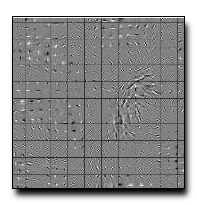
We present an energy-based model that uses a product of generalised
Student-t distributions to capture the statistical structure in datasets. This
model is inspired by and particularly applicable to natural datasets such
as images. We begin by providing the mathematical framework, where
we discuss complete and overcomplete models, and provide algorithms
for training these models from data. Using patches of natural scenes we
demonstrate that our approach represents a viable alternative to independent components analysis as an interpretive model of biological visual
systems. Although the two approaches are similar in flavor there are also
important differences, particularly when the representations are overcomplete. By constraining the interactions within our model we are also able
to study the topographic organization of Gabor-like receptive fields that
are learned by our model. Finally, we discuss the relation of our new approach to previous work in particular Gaussian Scale Mixture models,
and variants of independent components analysis.
Download: pdf
Text Reference
Simon Osindero, Max Welling, and Geoffrey E. Hinton.
Topographic product models applied to natural scene statistics.
Neural Comput., 18(2):381–414, 2006.
doi:http://dx.doi.org/10.1162/089976606775093936.
BibTeX Reference
@article{OsinderoWH_NC_2005,
author = "Osindero, Simon and Welling, Max and Hinton, Geoffrey E.",
TAG = "ecological_statistics",
title = "Topographic Product Models Applied to Natural Scene Statistics",
journal = "Neural Comput.",
volume = "18",
number = "2",
year = "2006",
issn = "0899-7667",
pages = "381--414",
doi = "http://dx.doi.org/10.1162/089976606775093936",
publisher = "MIT Press",
address = "Cambridge, MA, USA"
}
